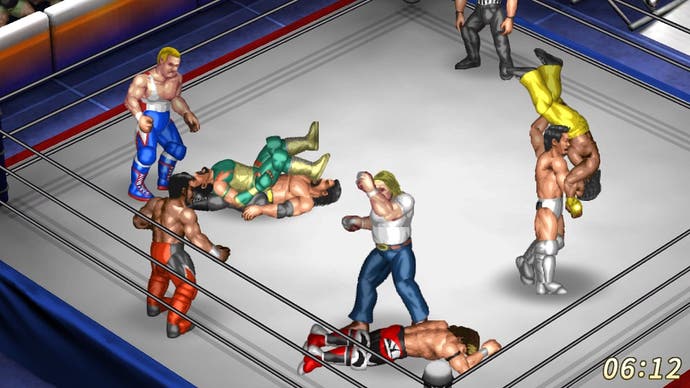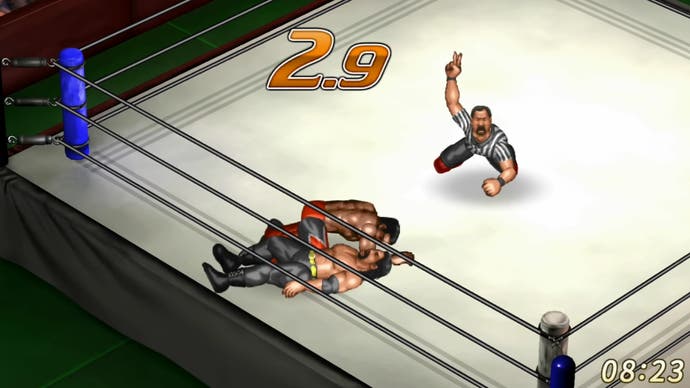The cult of Fire Pro Wrestling
Why is a niche 90s Japanese grappling sim enjoying a surprise renaissance on Steam?
Why do we care? Why do we care when Japanese megastar Kazuchika Okada and Canadian savant Kenny Omega pretend to fight each other for 60 electrifying minutes in the Tokyo Dome? Why do we care about AJ Styles, with his luscious hair and shiny blue gloves, making his surprise WWE debut at last year's Royal Rumble as his opponent Roman Reigns looks on shocked - despite the reality of the two probably sitting down to lunch together earlier that day?
Why do we care, when none of it is real? Because it doesn't matter. The drama. The danger. The glory and the tragedy. The preposterousness and pomposity and madness and athletic wonder; the moments that tread the lines between real and fake, the backstage politics and the stage-front fallout.
We all know professional wrestling is a fundamentally daft endeavour - especially when Mixed Martial Arts exists. But we now live in a world where no one is really pretending wrestling is real any more, and oddly that actually frees the performers up to act like it is real. Like any other TV show, the fans don't need to believe, they just want to suspend their disbelief.
The Japanese have known this for a long time, and their wrestling video games have reflected this innate understanding of the actual essence of puroresu. You may hear people raving still about AKI's Nintendo 64 wrestling sims. 20 years on, despite blocky character models and midi-synth looped guitar music, they're still a far better representation of wrestling than the shiny, lavish WWE 2K series. And that's because they understood one crucial thing - they're not supposed to be fighting games. They're supposed to be wrestling games, where mechanics and scripting fold into one another to create the only thing that truly matters in wrestling: drama.
There's another series that captures this extremely tricky balance - one that has gathered a kind of cult around it for over two decades. Fire Pro Wrestling, with its staunchly old-school 2D visuals and sparse Western releases, has long been seen by its cultish fanbase as the pinnacle of the genre, but most people in the West have no real idea why. The Fire Pro games lack the licenses that brought the AKI games mainstream attention; they're quite impenetrable if you're not schooled in their odd mechanics; and, typically, they've been very hard to get hold of.

Until now, that is. Fire Pro Wrestling World quietly entered Early Access on Steam a few weeks ago, and has already created quite a storm - especially as the last Fire Pro-branded game to make it to our shores was a godawful avatar-fuelled mess that appeared on Xbox Live Arcade in 2012. (That game should have been kept as far away from the Fire Pro name as Hulk Hogan from hidden dictaphones.) The world has changed since Fire Pro's 90s heyday, and those unexplained mechanics are now easily digestible with just a couple of Google searches - or, alternatively, in Fire Pro Wrestling World's demanding tutorial, which is confusingly entitled 'mission mode'.
It's a curious game, this, especially when placed side-by-side with the grappling sims most people are used to. Strikes often seem to clip straight through opponents, moves regularly don't work at all, and the wrestlers are constantly 'locking up' (where they both enter a classical collar-and-elbow tie-up).
And yet, despite these oddities, Fire Pro Wrestling World and its ancestors are deceptively simple tests of timing. Those constant lock-ups are key; you can't initiate a grapple on an opponent yourself, just walk close enough and both fighters will elaborately connect to one another. The trick is to watch for their feet to hit the mat, and listen carefully for that familiar reverberating stomp sound. All you then need to do is execute an input (the appropriate button for small, medium or 'big', and a d-pad direction) and if you win the timing battle, your fighter will execute a move.
Why, then, does your opponent sometimes reverse everything you try, or you do the same to them? Well, hidden behind the curtain are Fire Pro's stamina and damage systems. There are no meters, just animation cues and an expectation that the player understands some of the basic tenets of wrestling.

You're probably not going to be able to pull off a giant powerbomb or tiger driver at the start of a match when both fighters are fresh - it will get reversed. Best sticking with small attacks until you can see your opponent wearing down. Even if you're constantly on the offensive, though, you'll have to make judicious use of 'have a breather' to manage your own stamina. As I said, there are no meters to guide you here, just intuition and animation.
These are dynamics stripped not from fighting but from the manufactured drama of pro wrestling, and they work in tandem with the demanding timing mechanics to create long, drawn-out spectacles where the advantage swings wildly in either wrestler's favour throughout the bout, and where the bad guy (the 'heel') can suddenly introduce a weapon to completely change the complexion of a match.
Perhaps the strangest thing about Fire Pro, though, is how little its rabid fan base actually seems to care about winning. Rankings, leaderboards, winstreaks... these are nowhere near as important as a Fire Pro bout's most crucial number: the match rating.
High scores are given if a match is full of incident, of varied moves, of pacing and of what wrestling fans and practitioners call psychology (essentially, making the unbelievable believable through a commitment to character and storytelling). It's why you'll see Fire Pro players deliberately taking a rest and inviting their opponent to capitalise with a big move. It's why the fervently popular subreddit r/FirePro is filled with 'five-star' matches whose thread titles won't even mention the winner. It's why there's a whole community within Fire Pro who don't even play, they just sim matches with AI. Fire Pro World is already shaping up to be the ultimate version of what is, essentially, a digital wrestling playset.

This commitment to representing the reality of pro wrestling has been woven into the series' DNA for a long time, and we have a familiar name to thank for much of that. The one and only Goichi Suda, aka Suda 51, cut his teeth directing Fire Pro games in the 90s, even penning a story mode that saw the main character killing himself at the end. Very Suda, then, but quite a bold move for a mid-90s 16-bit wrestling game.
Speaking to Retro Gamer, Suda explained the mindset behind such a brave storytelling choice. "The final boss is a guy named Dick Slender, which is a parody of Ric Flair, and so originally I thought, we can have two endings here - one, you beat the guy and you get the happy ending, the other, you lose and get the bad ending. In the end, I didn't decide to go with the two endings - instead, you go on and beat the last boss, he gets all the acclaim from the crowd, from the people, and the screen gradually goes from white, to black. It shows his house, and he's committed suicide.
"For me, it was like an apotheosis - he had become a God." Suda tells us, pointedly. "It turned into a shitstorm," he laughs. Wrestling. It's a serious business.
Currently, Fire Pro Wrestling World lacks any kind of story mode. In fact, its whole UI still needs a lot of work. There are laggy character select menus, endlessly looping guitar riffs and a player select screen so confusing that there are multiple threads on reddit and GameFAQs asking how to actually start a match where you control one of the wrestlers. (The game defaults, somewhat tellingly, to CPU v CPU, with no obvious way to change it!)
However, where it earns that 'World' moniker is in its connectivity. The online lobbies need work, but they do offer connected play, leagues, tournaments and more - and for the true wrestling nerds out there, it's the Steam Workshop support that has them shining up their spandex.
It's already possible to download, near instantly, brilliantly realised versions of the entire WWE roster, NJPW stars, wrestling legends, fighting game characters and anyone else you can think of, complete with comprehensive move sets and even alternate outfits. This really hammers home Fire Pro World's status as the ultimate toolkit for wrestling fans, letting us recreate classic matches or conjure up dream bouts ad infinitum. And of course, if you're feeling creative, the same edit suite used to build out the roster is free for you to use too, and to share your creation with the globe.
(If you are playing, by the way, and wondering where the hell all those wrestlers you downloaded have gone: you have to enter the 'team' section of the edit mode and take all your new warriors out of the 'retired' pool, which makes about as much sense as an Ultimate Warrior promo. But I guess them's the breaks when you're playing a small-budget Japanese early-access retro wrestling game.)
Notwithstanding the rough edges, Fire Pro Wrestling World is a very fine game. It's quite obviously the type of fan service the series' cult following would lose their mind over (and they duly have). But it's also a great and, finally, easily accessible point of entry to Fire Pro for fans of digital wrestling the world over - and a release that gets closer to the heart of pro wrestling than just about any other video game you can name.


